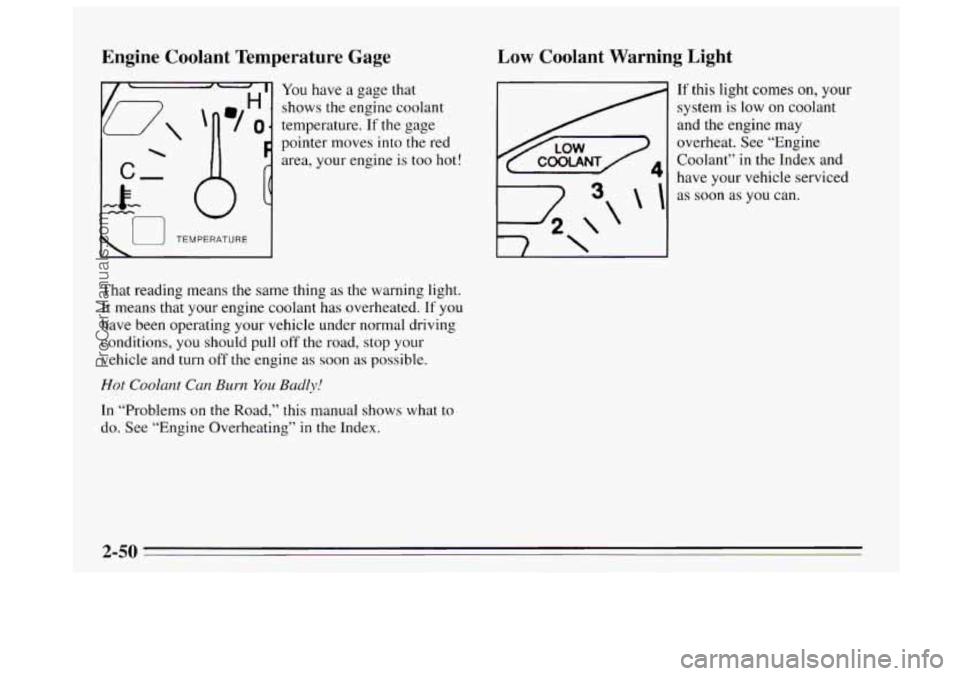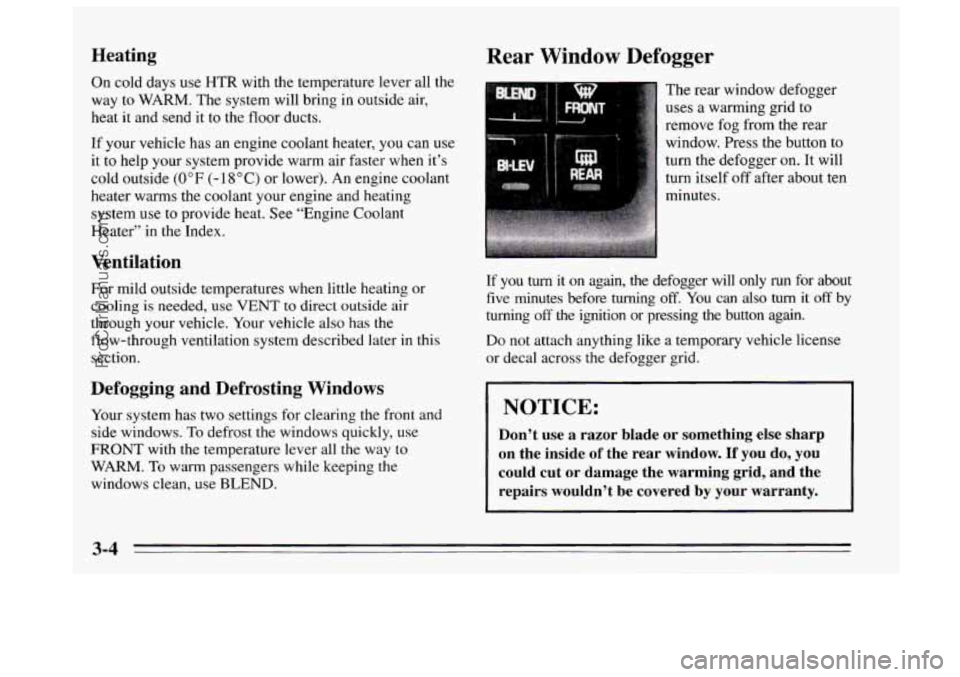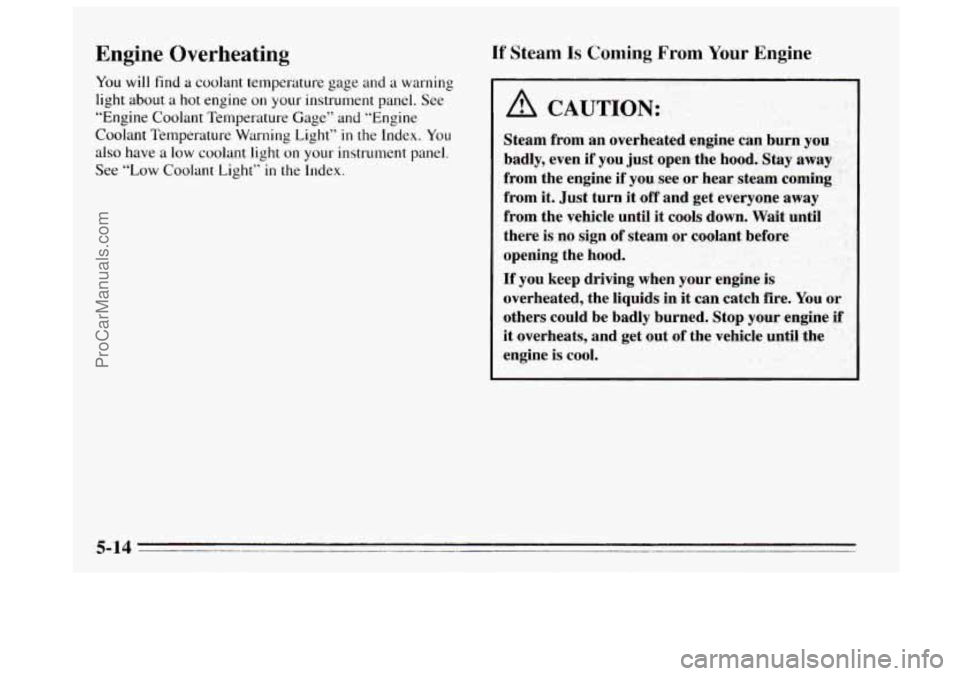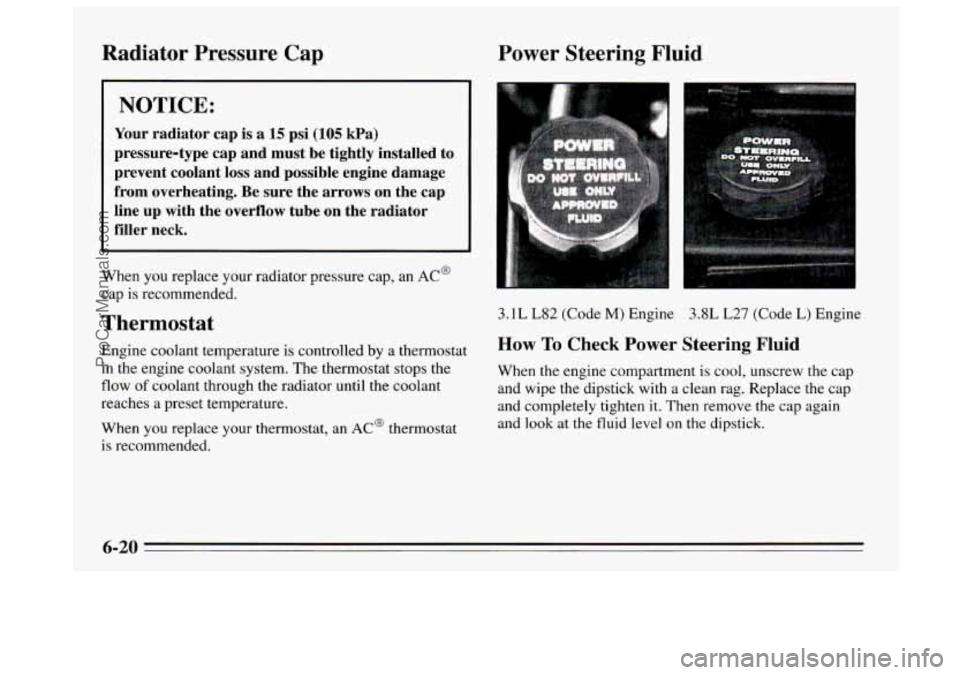1995 BUICK REGAL coolant temperature
[x] Cancel search: coolant temperaturePage 111 of 340

Anti-Lock Brake System Active Light
When your anti-lock system
is adjusting brake pressure
to help avoid a braking skid,
the
LOW TRAC light will
Engine Loolant Temperature Light
This light tells you that
your engine coolant has
overheated or your radiator
CYL hhh cooling fan is not working.
Slippery road conditions will exist
if this light comes on,
so adjust your driving accordingly. The light will stay on
for
a few seconds after the system stops adjusting brake
pressure.
The
LOW TRAC light also comes on briefly, as a bulb
check, when the engine is started. If the light doesn’t
come on then, have it fixed
so it will be there to tell you
when the system is active. If
you have been
operating your vehicle under normal
driving conditions, you should pull off the road, stop
your vehicle and turn off the engine as soon as possible.
Hot Coolant Can Burn You Badly!
In “Problems on the Road,” this manual shows what to
do. See “Engine Overheating” in the Index.
2-49
ProCarManuals.com
Page 112 of 340

Engine Coolant Temperature Gage
You have a gage that
shows the engine coolant
temperature.
If the gage
pointer moves into the red
area, your engine is too hot!
I u TEMPERATURE I
That reading means the same thing as the warning light.
It means that your engine coolant has overheated.
If you
have been operating your vehicle under normal driving
conditions, you should pull
off the road, stop your
vehicle
and turn off the engine as soon as possible.
Hot Coolant Can Burn You Badly!
In “Problems on the Road,” this manual shows what to
do. See “Engine Overheating” in the Index.
Low Coolant Warning Light
\I
4 \‘
If this light comes on, your
system
is low on coolant
and the engine may
overheat. See “Engine
Coolant” in the Index and
have your vehicle serviced
as soon as you can.
2-50
ProCarManuals.com
Page 120 of 340

Heating
On cold days use HTR with the temperature lever all the
way to WARM. The system will bring in outside air,
heat it and send it to the floor ducts.
If your vehicle has an engine coolant heater, you can
use
it to help your system provide warm air faster when it’s
cold outside
(0°F (-18°C) or lower). An engine coolant
heater warms the coolant your engine and heating
system use to provide heat. See “Engine Coolant
Heater” in
the Index.
Ventilation
For mild outside temperatures when little heating or
cooling
is needed, use VENT to direct outside air
through your vehicle. Your vehicle also
has the
flow-through ventilation system described later in this
section.
Defogging and Defrosting Windows
Your system has two settings for clearing the front and
side windows.
To defrost the windows quickly, use
FRONT with the temperature lever all the way to
WARM.
To warm passengers while keeping the
windows clean, use
BLEND.
Rear Window Defogger
The rear window defogger
uses
a warming grid to
remove fog from the rear
window. Press the button to
turn the defogger on. It will
turn itself off after about ten
minutes.
If you
turn it on again, the defogger will only run for about
five minutes before turning
off. You can also turn it off by
turning
off the ignition or pressing the button again.
Do not attach anything like a temporary vehicle license
or decal across the defogger grid.
1 NOTICE:
Don’t use a razor blade or something else sharp
on the inside
of the rear window. If you do, you
could cut or damage the warming grid, and the
repairs wouldn’t be covered by your warranty.
3-4
ProCarManuals.com
Page 188 of 340

Engine Overheating
You will find a coolant temperature gage and a warning
light about
a hot engine on your instrument panel. See
“Engine Coolant Temperature Gage” and “Engine
Coolant Temperature Warning Light”
in the Index. You
also have a low coolant light on your instwrnent panel.
See “Low Coolant Light”
in the Ilrdex.
If Steam Is Coming From Your Engine
A CAUTION:
Steam from an overheated engine can burn you
badly, even if you just open the hood. Stay away
from the engine
if you see or hear steam corning
from it. Just turn
it off and get everyone away
from the vehicle until it cools down. Wait until
there is no sign of steam
or coolant before
opening the hood.
If you keep driving when your engine is
overheated, the liquids in it can catch fire. You or
others could be badly burned. Stop your engine
if
it overheats, and get out of the vehicle until the
engine is cool.
ProCarManuals.com
Page 225 of 340

How to Add Fluid
Refer to the Maintenance Schedule to determine what
kind of transaxle fluid to use. See “Recommended
Fluids and Lubricants”
in the Index.
If the fluid level is low, add only enough of the proper
fluid to bring the level into the cross-hatched area on the
dipstick.
1. Pull out the dipstick.
2. Using a long-neck funnel, add enough fluid at the
dipstick hole
to bring it to the proper level.
It doesn’t take much fluid, generally less than a pint
(OSL). Don ’t ouefill. We recommend you use only fluid
labeled DEXRON@-111, because fluid with that label is
made especially for your automatic transaxle. Damage
caused by fluid other than DEXRON@-I11 is not covered
by your new vehicle warranty.
After adding fluid, recheck the fluid level as
described under “How
to Check.”
When the correct fluid level is obtained, push the
dipstick back in all the way.
Engine Coolant
The following explains your cooling system and how to
add coolant when it is low. If you have a problem with
engine overheating or if
you need to add coolant to your
radiator, see “Engine Overheating” in the Index.
The proper coolant for your Buick will:
Give freezing protection down to -34°F (-37°C).
Give boiling protection up to 262 OF (1 28 O C).
Protect against rust and corrosion.
Help keep the proper engine temperature.
Let the warning lights work as they should.
What to Use
Use a mixture of one-half clean water (preferably
distilled) and one-half antifreeze that meets “GM
Specification
1825-M,” which won’t damage aluminum
parts. You can also use a recycled coolant conforming to
GM Specification 1825-M with a complete coolant flush
and refill. Use GM Engine Coolant Supplement (sealer)
with any complete coolant flush and refill.
If you use
this mixture, you don’t need to add anything else.
~
6-17
ProCarManuals.com
Page 228 of 340

Radiator Pressure Cap Power Steering Fluid
NOTICE:
Your radiator cap is a 15 psi (105 kPa)
pressure-type cap and must be tightly installed to
prevent coolant loss and possible engine damage
from overheating. Be sure the arrows
on the cap
line up with the overflow tube on the radiator
filler neck.
When you replace your radiator pressure cap, an AC@
cap is recommended.
Thermostat
Engine coolant temperature is controlled by a thermostat
in the engine coolant system. The thermostat stops the
flow of coolant through the radiator until the coolant
reaches a preset temperature.
When you replace your thermostat, an
AC@ thermostat
is recommended. 3.1L
L82 (Code M) Engine
3.8L L27 (Code L) Engine
How To Check Power Steering Fluid
When the engine compartment is cool, unscrew the cap
and wipe the dipstick with a clean rag. Replace the cap
and completely tighten
it. Then remove the cap again
and look at the fluid level
on the dipstick.
6-20
ProCarManuals.com
Page 329 of 340

Checking Automatic Transaxle Fluid
..................... 6- IS
Brake Fluid ................................. 6-23
Engine Coolant
.............................. 6- 18
Engine Oil ................................... 6-8
Power Steering Fluid ......................... 6-20
Restraint Systems
............................ 1-50
Things Under the Hood
........................ 6-6
Chemical Paint Spotting
.......................... 6-44
Child Restraints
................................ 1-37
(2-Door Models)
........................... 1-38
(4-Door Models) ........................... 1-40
Securing
in the Center Rear Seat Position ......... 1-42
Securing in the Right Front Seat Position .......... 1-44
TOP Strap ................................... 1-38
Where to Put ................................ 1-37
Cigarette Lighter ............................... 2-4 I
Power Options ................................ 6-53
City Driving
................................... 4- 17
Cleaner. Air ................................... 6-13
Aluminum Wheels ........................... 6-43
Fabric
..................................... 6-39
Glass ...................................... 6-41
Inside of Your Buick .......................... 6-38
Securing in a Rear Outside Seat Position
Securing
in a Rear Outside Seat Position
Circuit Breaker. Power Windows and Other
Cleaning
Leather
.................................... 6-40
Outside of the Windshield and Wiper Blades ....... 6-41
Outside
01 Your Buick ........................ 6-42
Special Problems
............................ 6-39
Stains ...................................... 6-39
Tires
......................................... 43
Top
of the Instrument Panel .................... 6-41
Vinyl ...................................... 6-40
Clock. Setting The
............................... 3-5
Comfort Controls
................................
Bleed Valves ................................ 5-21
Heater, Engine
......................... 2- 14, 6- 13
How to Add to the Coolant Recovery Tank ........ 5-18
How to
Add to the Radiator .................... 5-20
Temperature Gage ............................ 2-50
Temperature Light
........................... 2-49
Cooling System
................................ 5-16
Courtesy Transportation
........................... 8-5
ProCarManuals.com
Page 331 of 340

Engine Coolant ................................. 6- 17
Adding
.................................... 6-18
Checking ................................... 6-18
Heater
................................ 2- 14. 6. I3
Temperature Gage
............................ 2-50
Temperature Light
........................... 2-49
Engineoil
..................................... 6-7
Additives
................................... 6-12
Checking
.................................... 6-8
What Kind to Use ............................ 6- IO
What to Do with Used Oil ..................... 6-13
When to Change
............................. 6- 12
Ethanol
(In Fuel) ................................ 6-3
Exhaust. Engine
................................ 2-23
Expectant Mothers. Use
of Safety Belts ............. 1-24
Extender. Safety Belt
............................ 1-50
Adding
..................................... 6-9
Fabric Cleaning
............................... 6-39
Fiberglass Springs
.............................. 6-44
Filling Your Tank ................................ 6-5
Filter
. Air Cleaner .............................. 6- 13
Finish Care .................................... 6-42
Finish Damage
................................. 6-43
First Gear. Automatic Transaxle
................... I 3-18
Fixed Mast Antenna ............................. 3- 19 Flashers
. Hazard Warning ......................... 5- I
Flat
Tire. Changing ............................. 5-24
Fluid Capacities
................................ 6-55
Fluid Levels. Maintenance
........................ 7-36
Fluids and Lubricants
............................ 7-40
Foreign Countries
. Fuel ........................... 6-4
Four-Way Manual Seat
........................... 1-2
Freeway Driving
............................... 4-18
French Language Manual
11
Fr011t Seatback Latches ........................... 1-5
Fuel .......................................... 6-3
Filling Your Tank
............................. 6-5
Gage
...................................... 2-44
In Foreign Countries
........................... 6-4
LowLight
.................................. 2-45
Fuse Block. Instrument Panel
..................... 6-48
Fuses and Circuit Breakers
....................... 6-47
.. ...........................
Gage . En. trine Coolant Temperature ............... 2-50
Gasoline
....................................... 6-3
Gasolines for Cleaner Air
......................... 6-4
GAWR
(Gross Axle Weight Rating) ................ 4-26
Gear Positions
................................. 2- IS
Glass. Cleaning ................................ 6-41
GloveBox ..................................... 2-8
GVWR (Gross Vehicle Weight Rating)
.............. 3-26
9-5
ProCarManuals.com